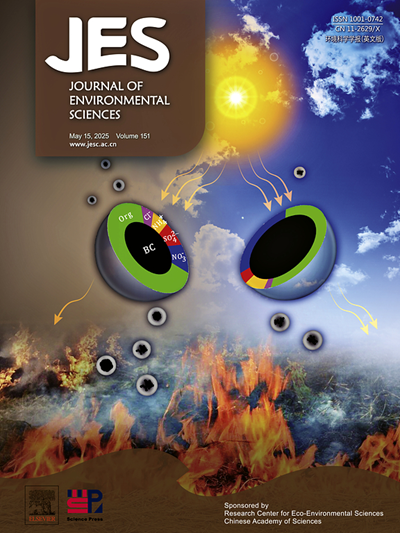Inhibitory mechanism of Macleaya cordata crude extracts on freshwater cyanobacterium Microcystis aeruginosa
IF 5.9
2区 环境科学与生态学
Q1 ENVIRONMENTAL SCIENCES
引用次数: 0
Abstract
A promising solution to combat harmful cyanobacterial blooms (CyanoHABs) is the use of naturally-derived cyanocidal compound. This study found that the crude extracts of the herbaceous plant Macleaya cordata can inhibit the growth of the bloom-forming cyanobacterium Microcystis aeruginosa. Growth inhibition test suggested that the inhibitory effect was significant at a concentration as low as 5 µg/L of the crude extracts. To comprehensively elucidate inhibitory mechanisms, we examined the responses in anti-oxidative systems, changes in triggering signals in cells, and hallmarks of programmed cell death (PCD) under the two levels of exposure to the crude extracts of M. cordata. A notable observation across all treatment groups was the significant increase in the superoxide dismutase activity of M. aeruginosa at 72 h. However, distinct patterns were observed in malondialdehyde (MDA), with no significant difference observed between the low concentration treatment group (5 µg/L) and the control group. In contrast, Microcystis cells subjected to high concentration (10 µg/L) exhibited a significant difference in MDA content at both 24 and 72 h. Furthermore, we observed that the levels of potential signaling molecules, e.g., intracellular reactive oxygen species, nitric oxide, and Ca2+ were altered in the Microcystis cells after exposure to the crude extracts. This results in alterations to the levels of signaling molecules, which in turn stimulate the upregulation of orthocaspase, leading to PCD and population collapse eventually. This study examines the mechanisms of Microcystis suppression through naturally-derived substances, providing theoretical and technical foundations for the sustainable management of CyanoHABs.

枸杞粗提物对淡水蓝藻铜绿微囊藻的抑制机制
一个有希望的解决方案,以打击有害的蓝藻华(氰habs)是使用天然衍生的杀氰化合物。本研究发现,草本植物Macleaya cordata粗提物可以抑制绿藻微囊藻(Microcystis aeruginosa)的生长。生长抑制试验表明,粗提物浓度低至5µg/L时,抑制效果显著。为了全面阐明抑制机制,我们研究了在两种暴露水平下抗氧化系统的反应,细胞中触发信号的变化以及程序性细胞死亡(PCD)的特征。在所有处理组中,一个值得注意的观察结果是,在72 h时,M. aeruginosa的超氧化物歧化酶活性显著增加。然而,在丙二醛(MDA)中观察到不同的模式,低浓度处理组(5µg/L)与对照组之间没有显著差异。相比之下,高浓度(10µg/L)处理的微囊藻细胞在24和72 h时MDA含量均有显著差异。此外,我们观察到暴露于粗提取物后,微囊藻细胞中潜在信号分子(如细胞内活性氧、一氧化氮和Ca2+)的水平发生了变化。这导致信号分子水平的改变,进而刺激正半乳糖酶的上调,最终导致PCD和种群崩溃。本研究探讨了天然衍生物质抑制微囊藻的机制,为蓝藻藻的可持续管理提供理论和技术基础。
本文章由计算机程序翻译,如有差异,请以英文原文为准。
求助全文
约1分钟内获得全文
求助全文
来源期刊

Journal of Environmental Sciences-china
环境科学-环境科学
CiteScore
13.70
自引率
0.00%
发文量
6354
审稿时长
2.6 months
期刊介绍:
The Journal of Environmental Sciences is an international journal started in 1989. The journal is devoted to publish original, peer-reviewed research papers on main aspects of environmental sciences, such as environmental chemistry, environmental biology, ecology, geosciences and environmental physics. Appropriate subjects include basic and applied research on atmospheric, terrestrial and aquatic environments, pollution control and abatement technology, conservation of natural resources, environmental health and toxicology. Announcements of international environmental science meetings and other recent information are also included.
 求助内容:
求助内容: 应助结果提醒方式:
应助结果提醒方式:


